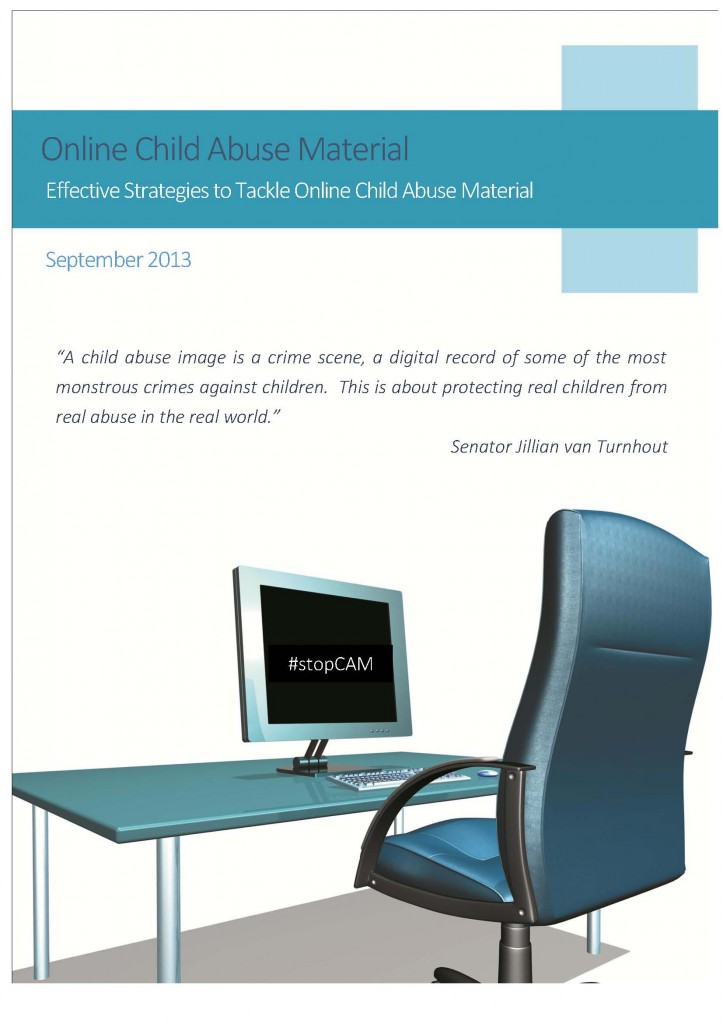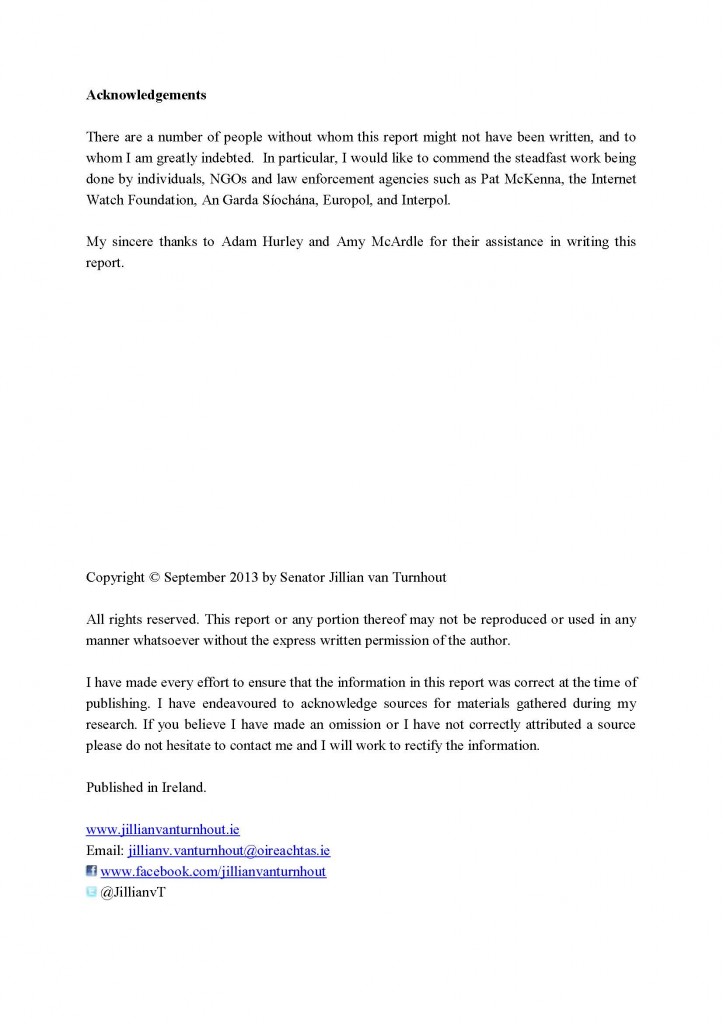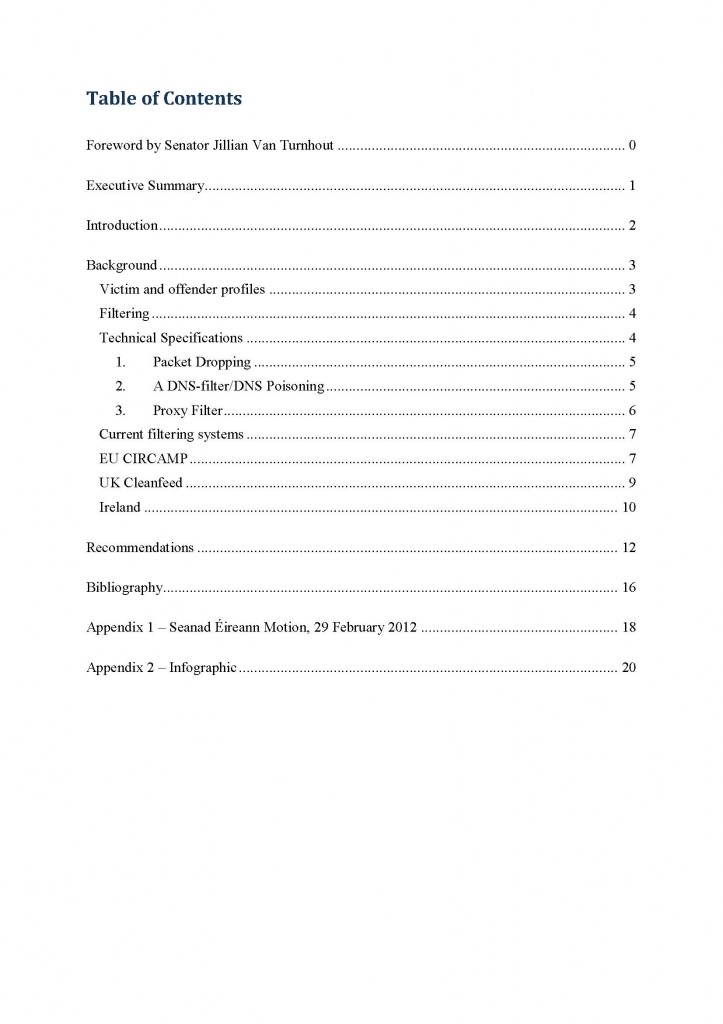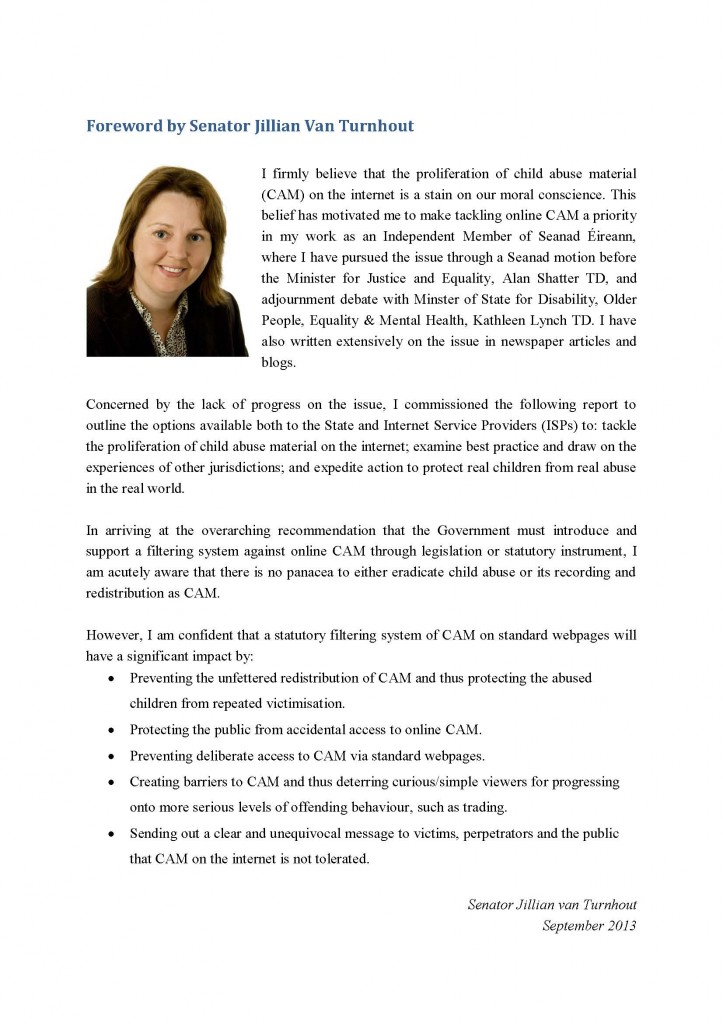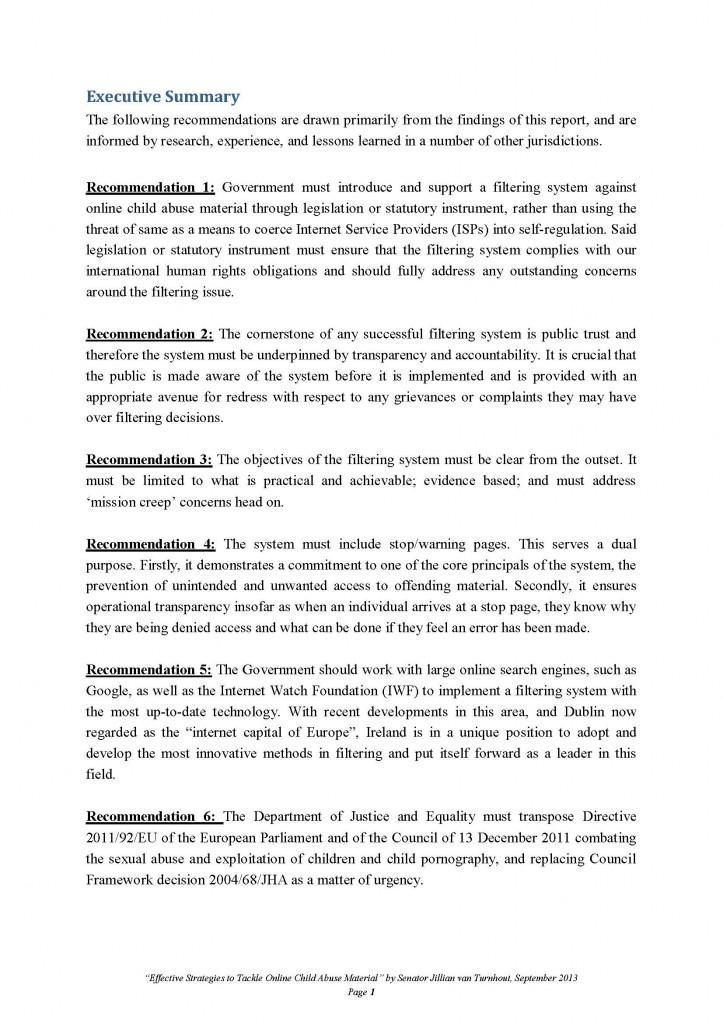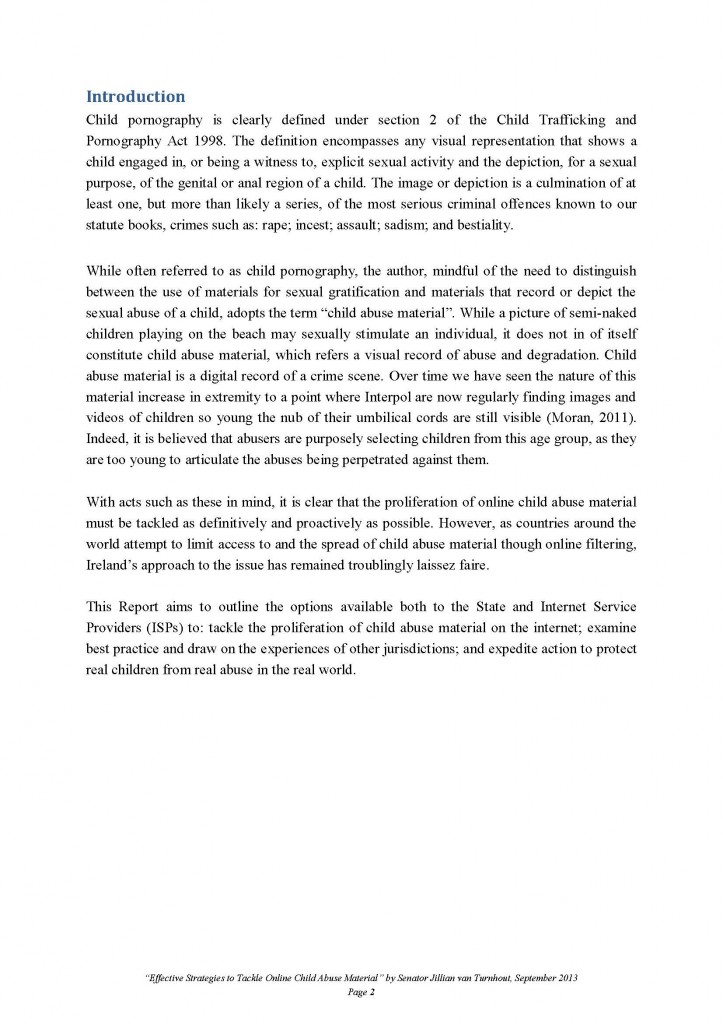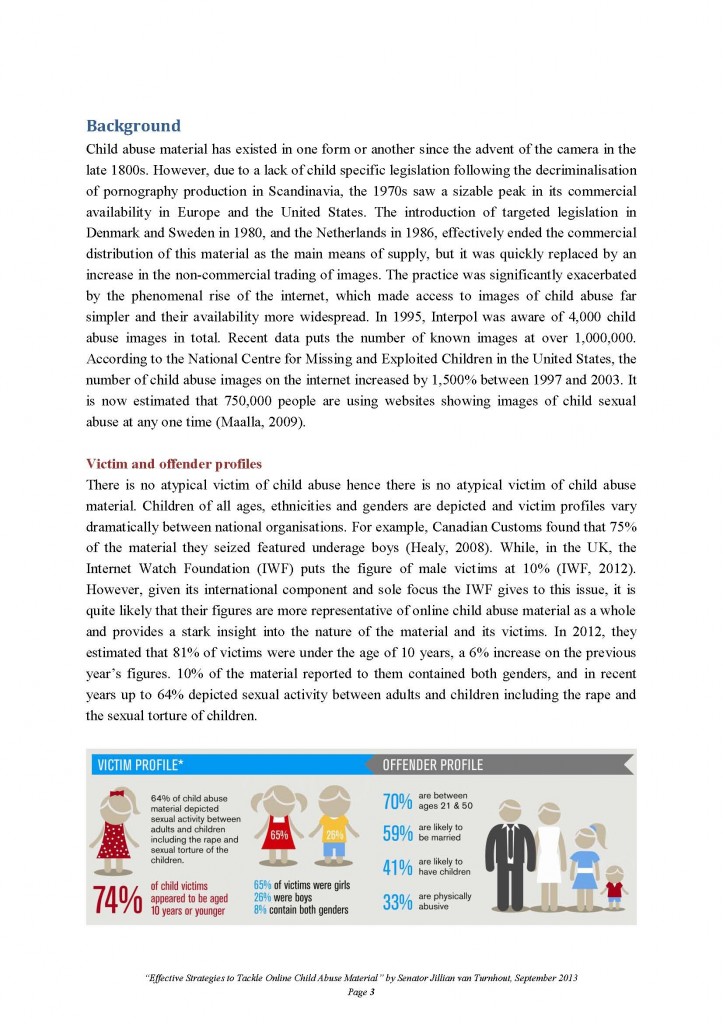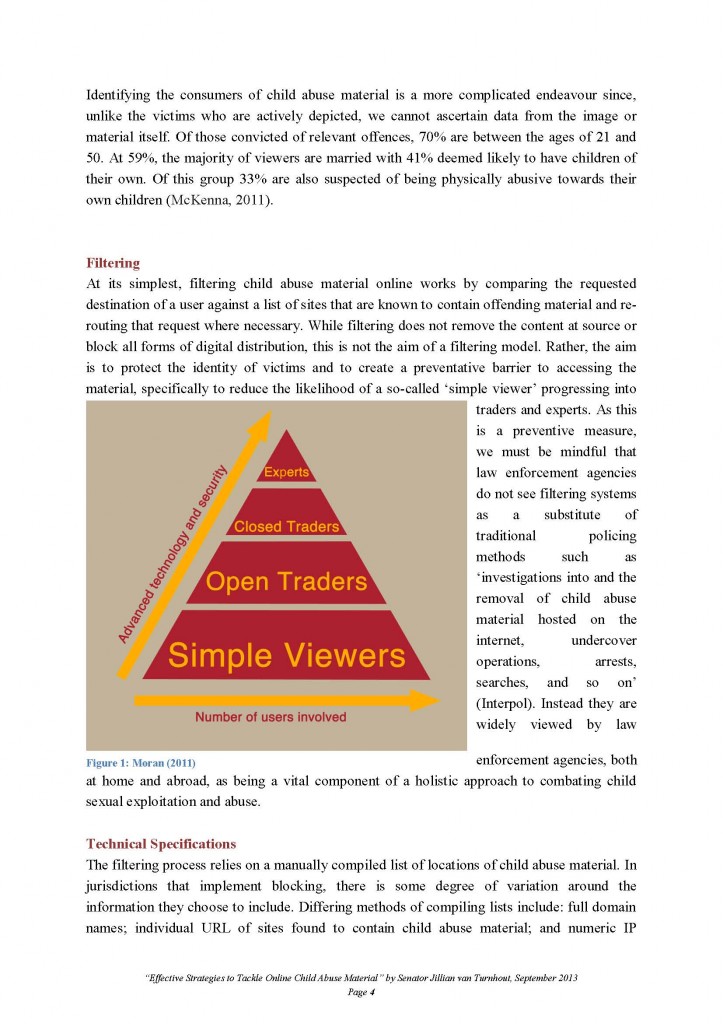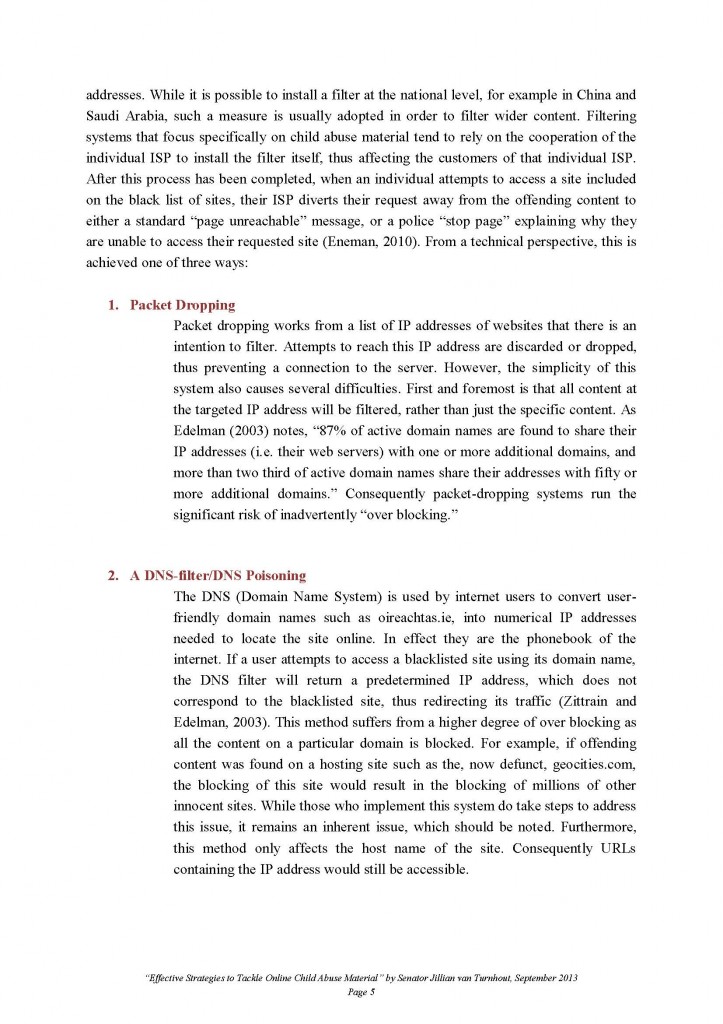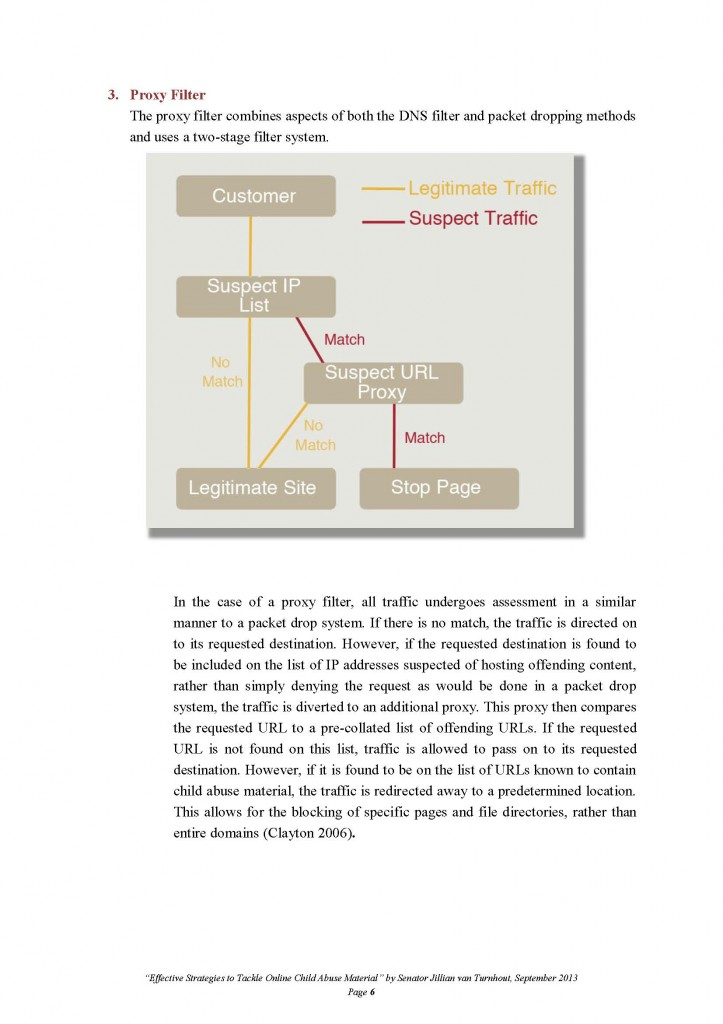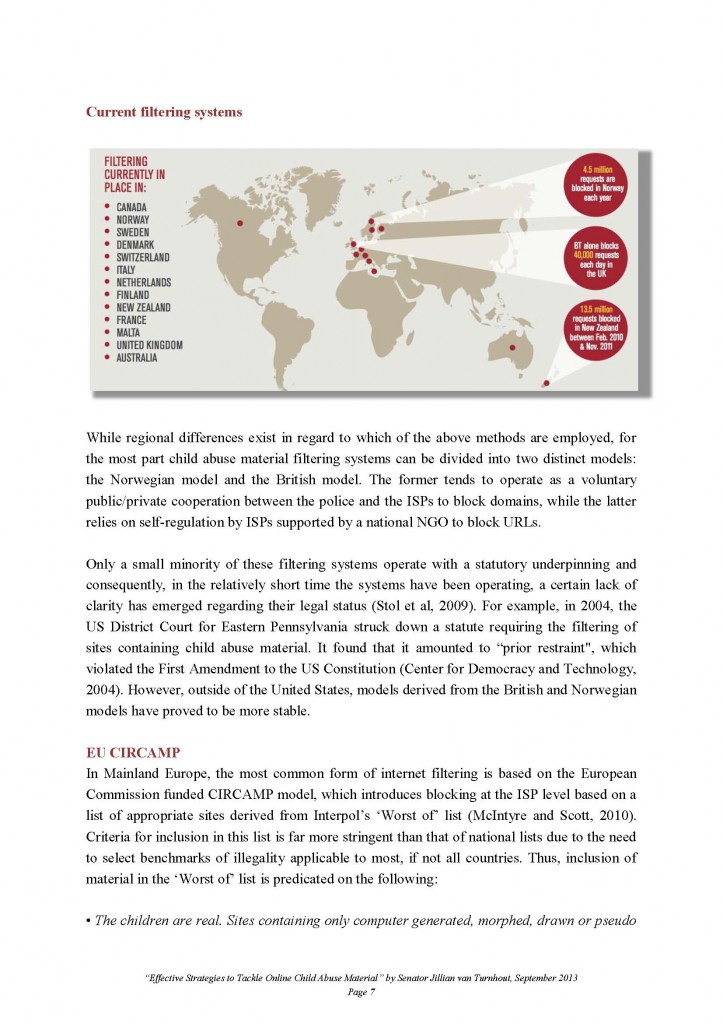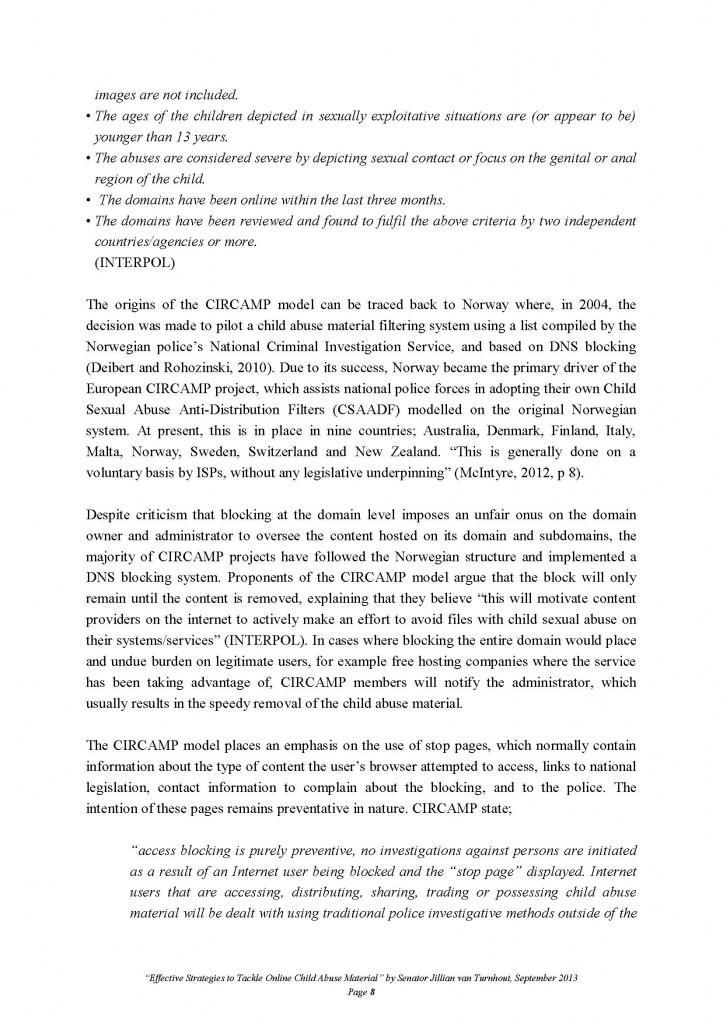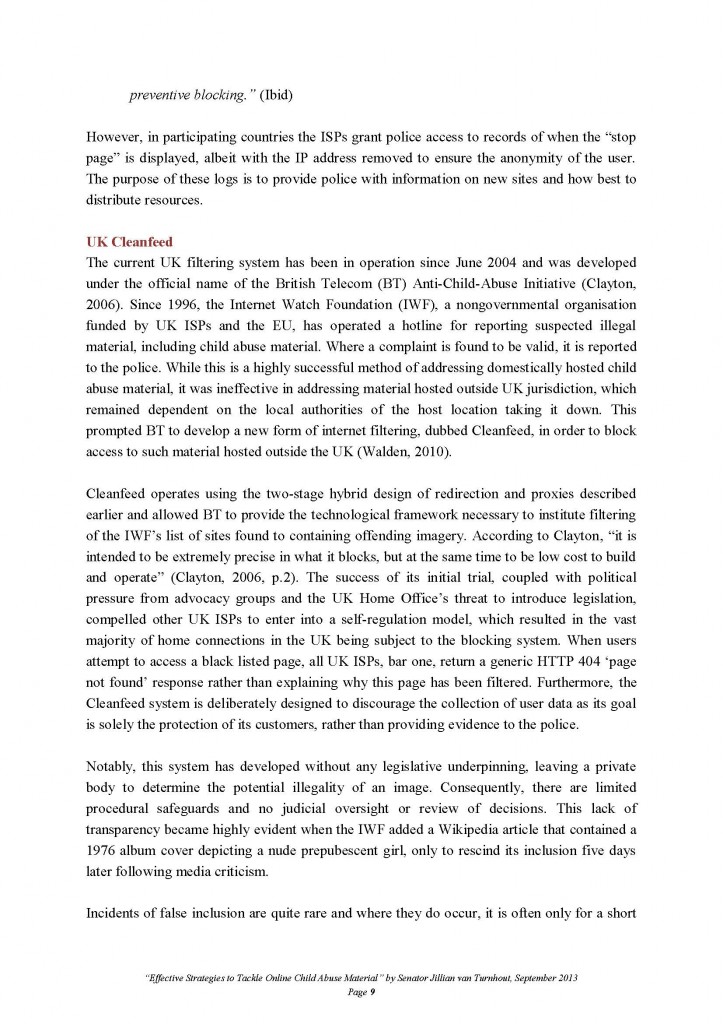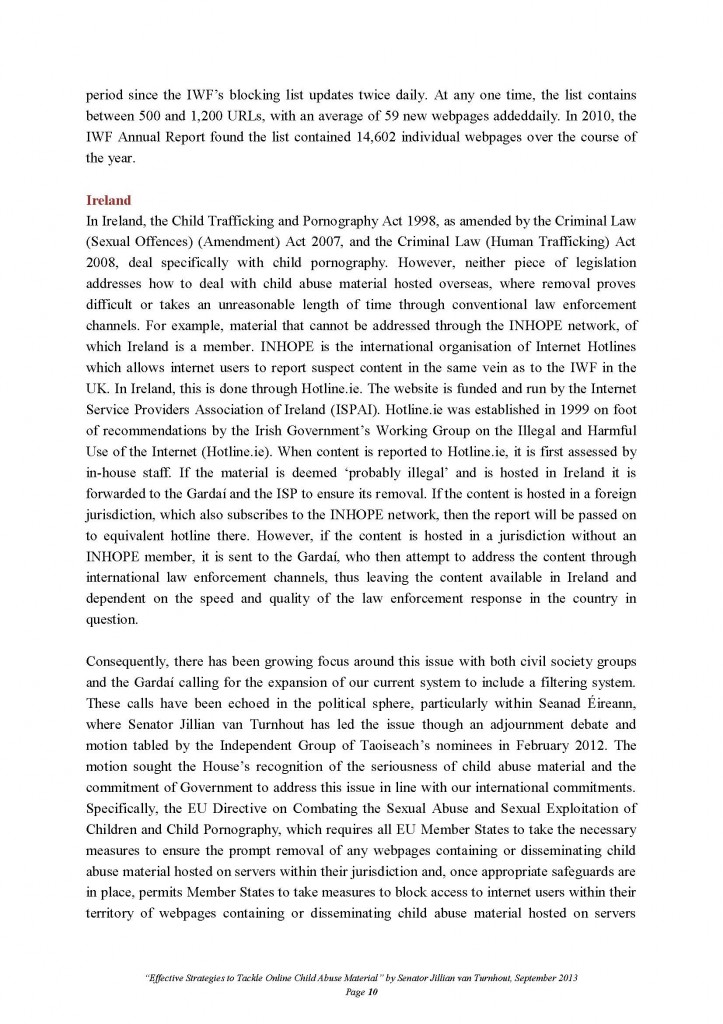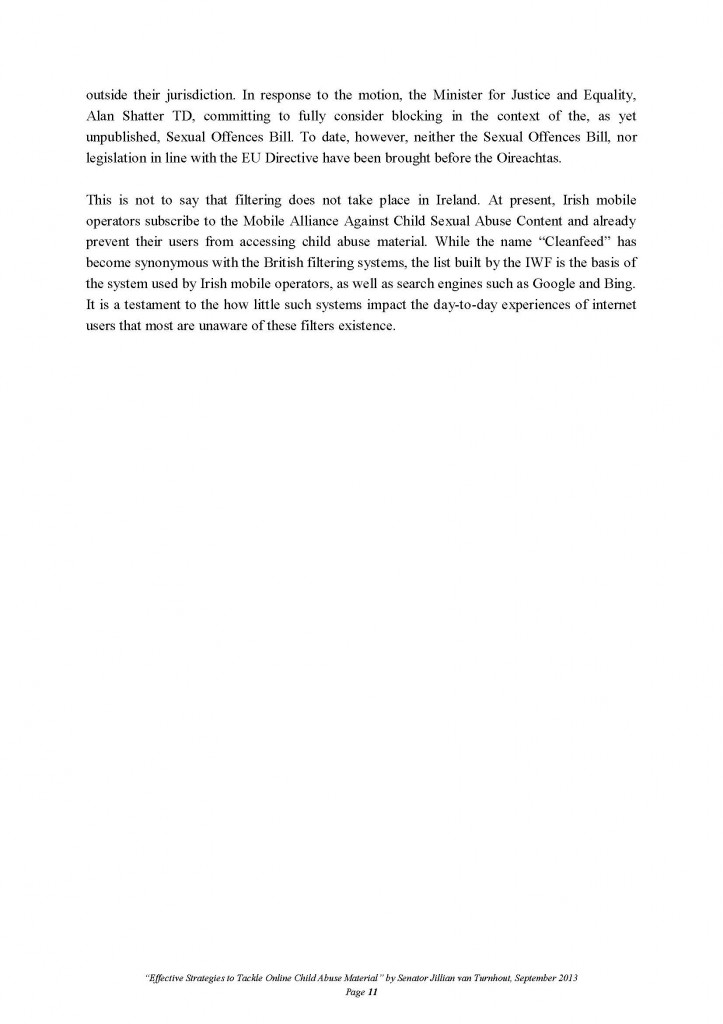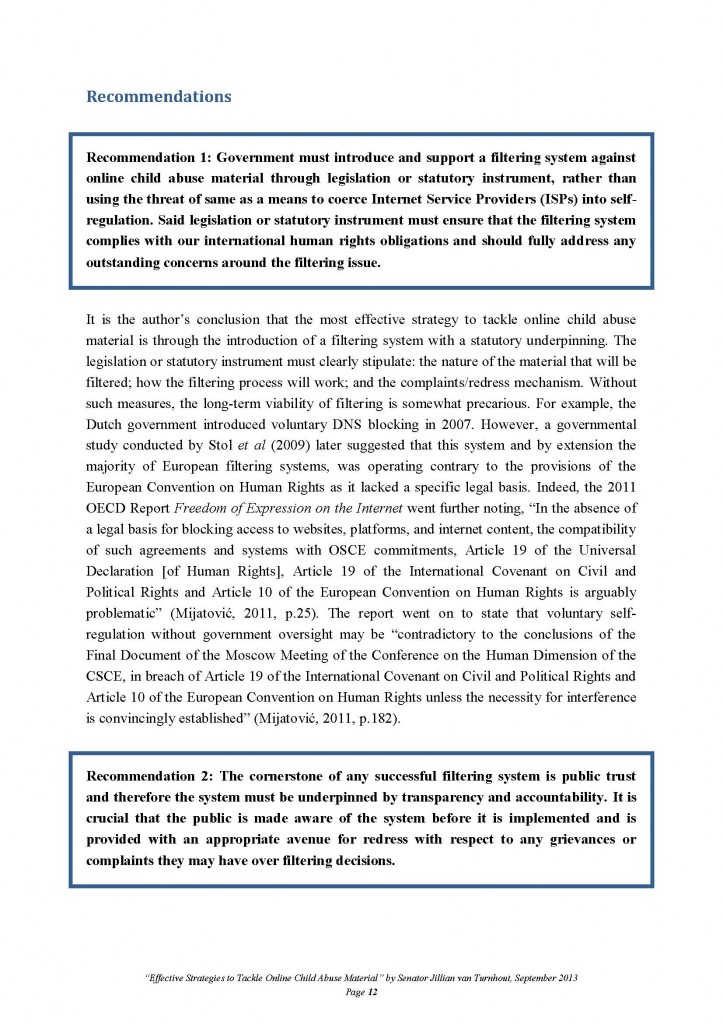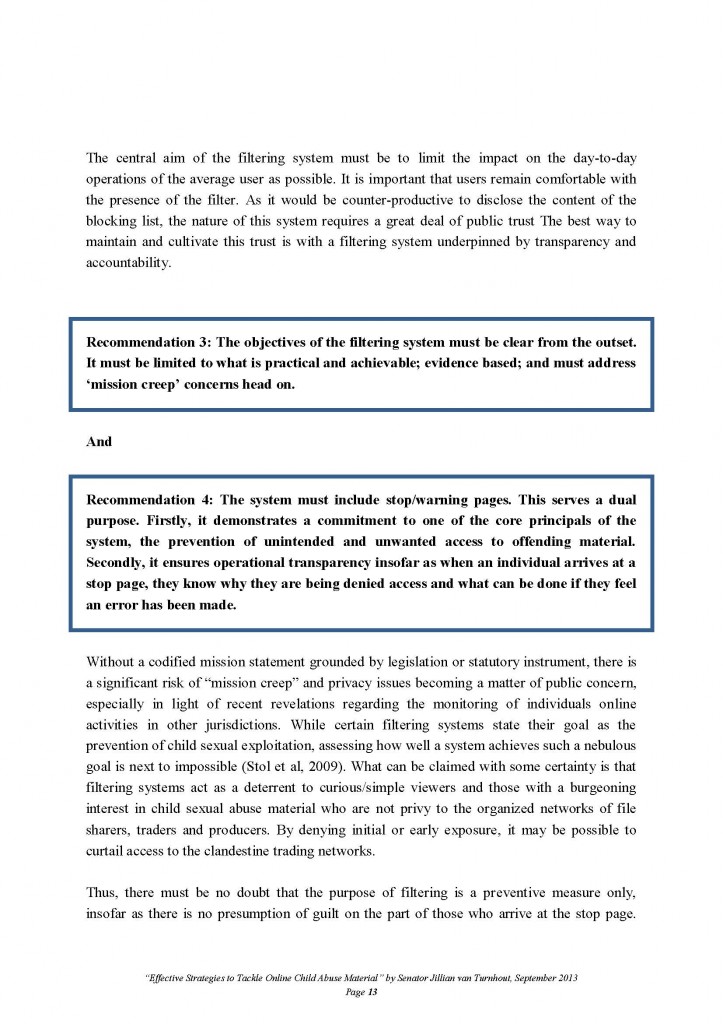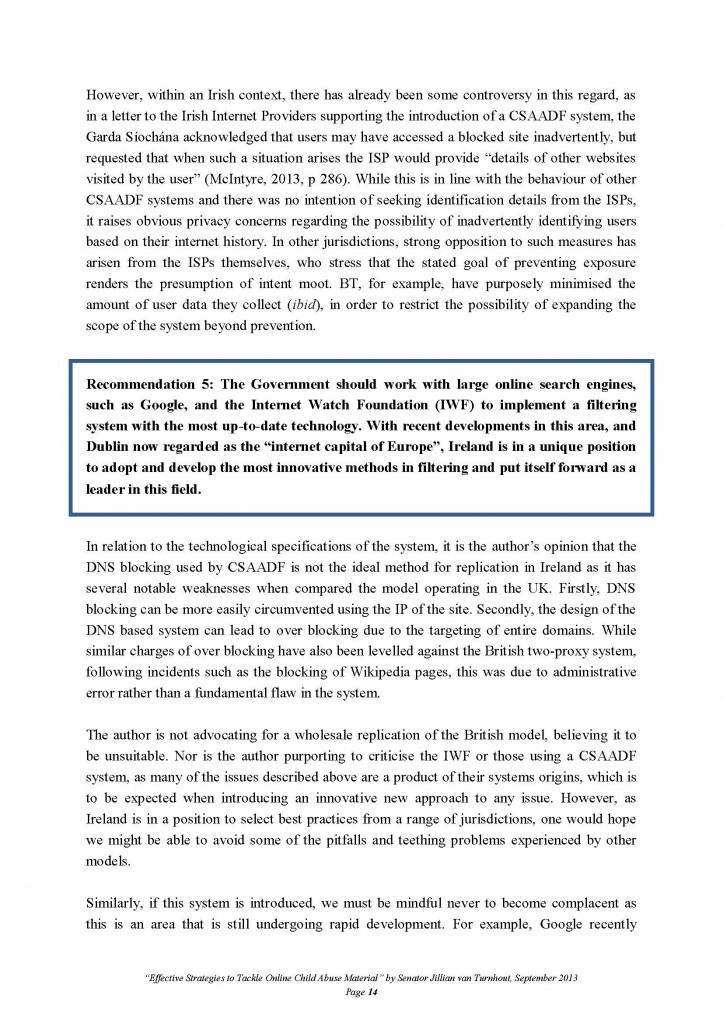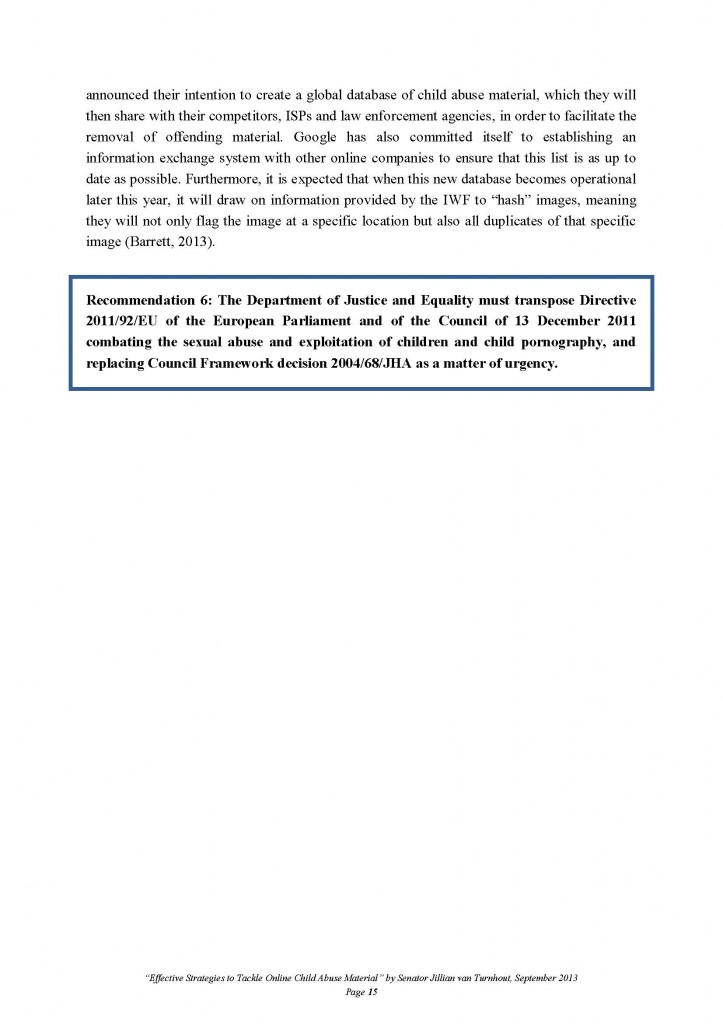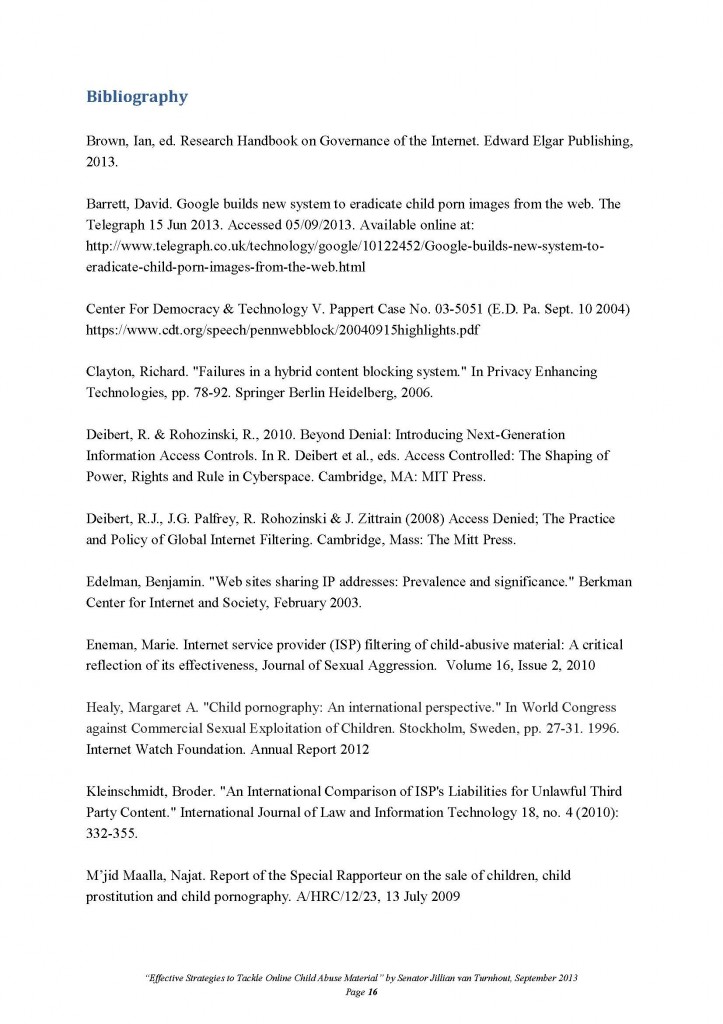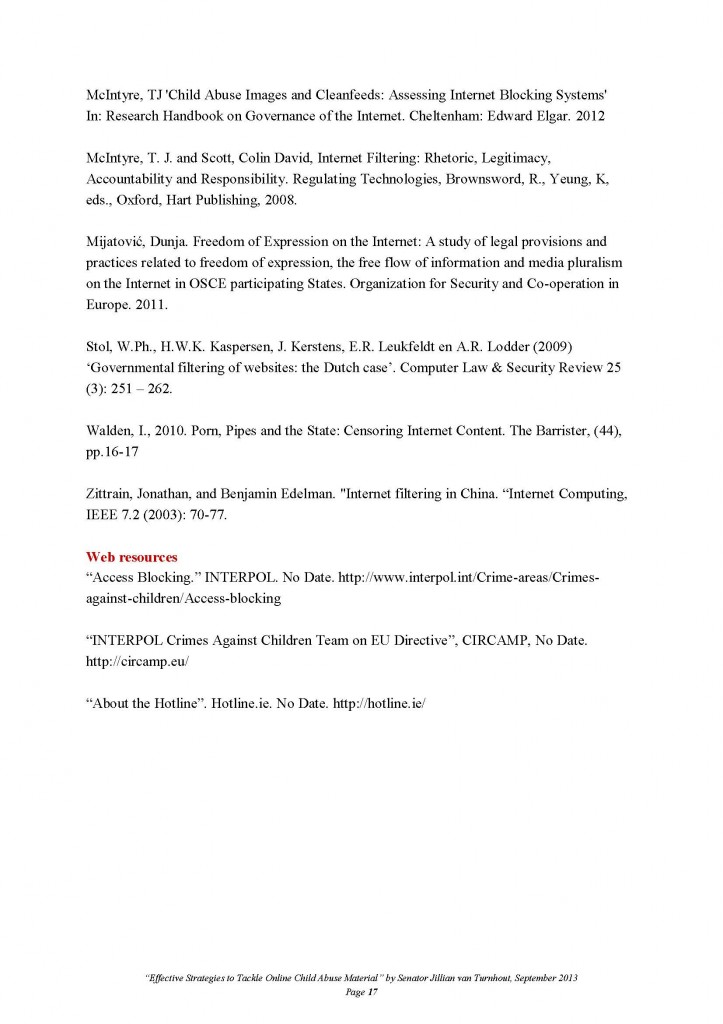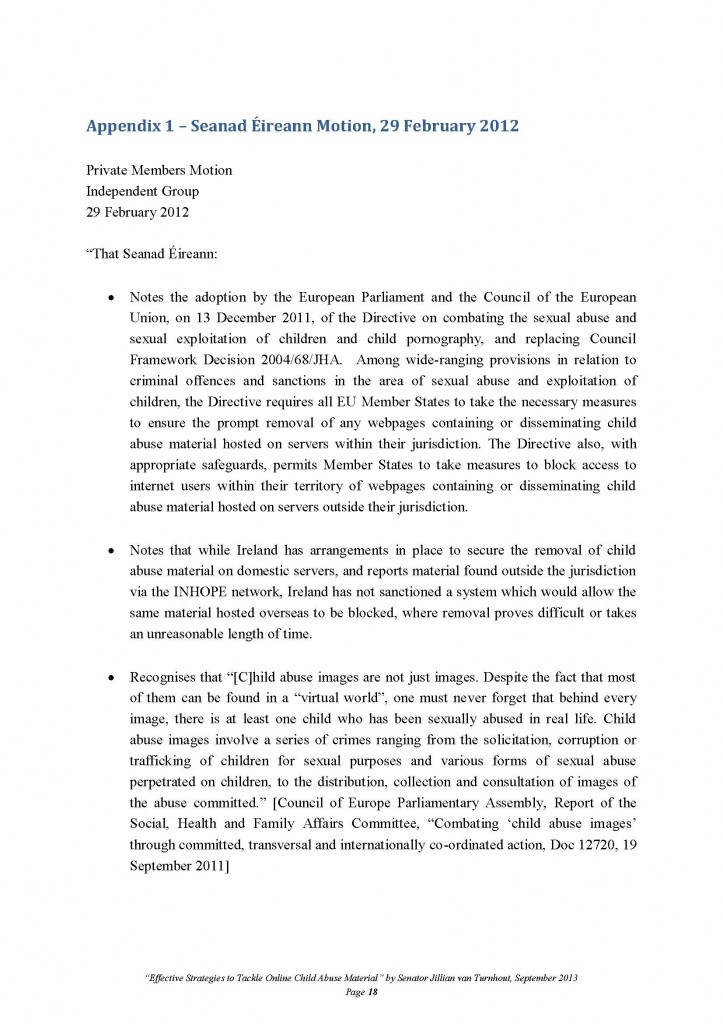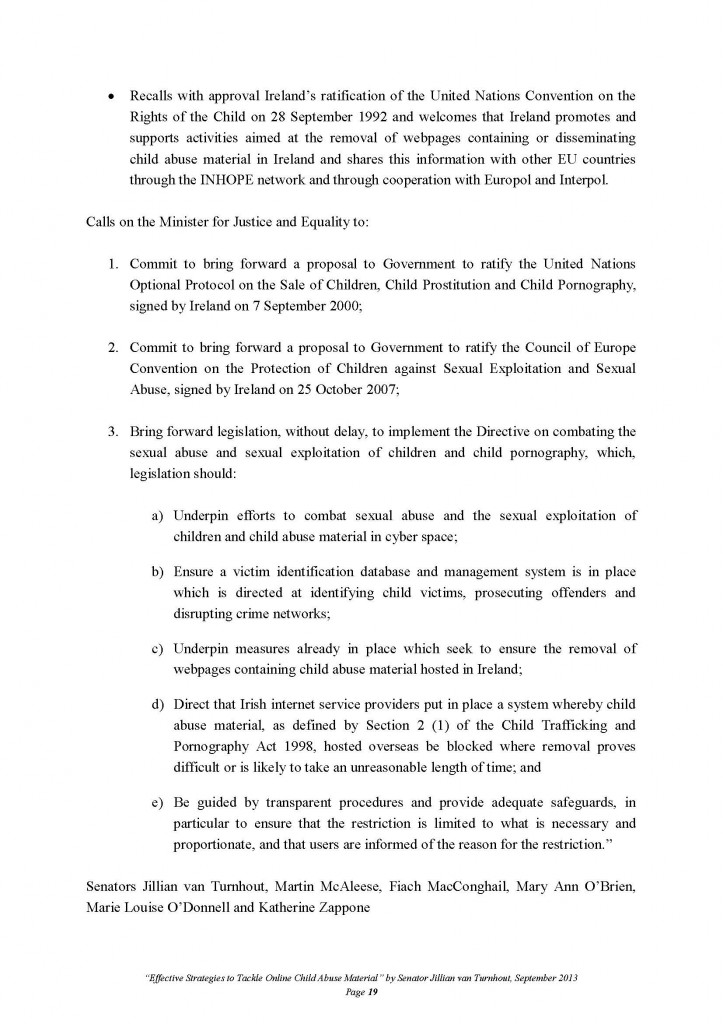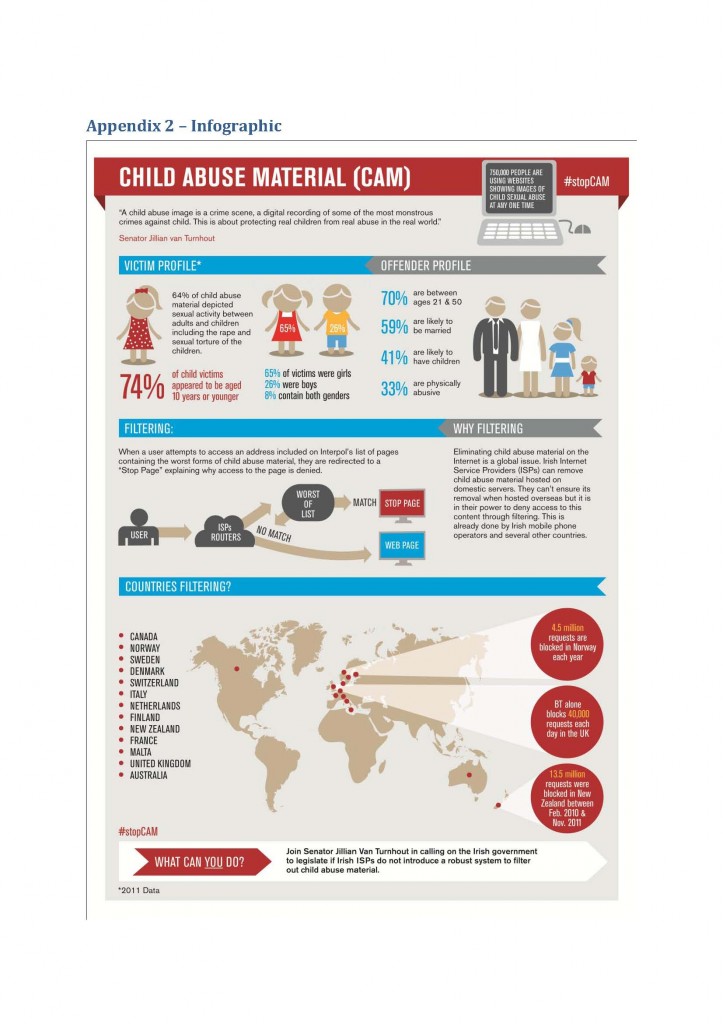Column: Blocking child porn isn’t about censorship. It keeps children safe.
21st March 2012
Column: Blocking child porn isn’t about censorship. It keeps children safe.
The rights of children must come first – and it’s time to block images of the worst sexual abuse, write Senators Deirdre Clune and Jillian van Turnhout.
CHILD ABUSE MATERIAL is often spoken about as “child pornography” but it is far more serious an offence than can be encompassed by any single definition. A child abuse image is a crime scene, a digital recording of rape, incest, assault, sadism and bestiality being perpetrated against a child.
The sheer horror of such images is closer in content to depictions of the atrocities of war by those who perpetrate them. It is imperative that Irish internet service providers move to block child abuse material to prevent the proliferation of these images.
Think for a moment about the most humiliating and degrading moment you have ever experienced. Think of the desperate helplessness you felt. Now imagine that someone had managed to capture that moment. That image was then spread across the globe so that no matter how far you ran you could never be sure that those you meet did not see it. Now imagine the scenario for a victim of child sexual abuse whose trauma has been recorded and disseminated for the sexual gratification of others. Try to comprehend the on-going harm that victim suffers as long as the image remains available for others to view, their sense of being re-abused again and again and being defined by defilement for ever.
Blocking child abuse material on the internet is not going to stop those who are determined to view it. Traders will share their collections via peer-to-peer, email and other services. The blocking measure is aimed at those who stumble across one image inadvertently and whose curiosity sparks a dangerous spiral, which leads them to seek out more. Interpol describes these individuals as ‘simple viewers,’ and their statistics show that one in three simple viewers go on to abuse a child themselves.
We live in the information age. A photo taken in one part of the world can reach into millions of homes within seconds of being uploaded. It can seem inconceivable that images of child abuse are being sought online. However, a huge volume of requests are made to access child abuse material, intentionally or accidentally, through standard webpages throughout the world. For example, 4.5 million requests are blocked in Norway each year; 13.5 million requests were blocked in New Zealand between February 2010 and November 2011; and BT alone blocks 40,000 requests each day in the UK.
’750,000 people are using websites displaying images of child sexual abuse at any one time’
In 2009,the UN-Special Rapporteur on the sale of children, child prostitution and child pornography, Najat M’jid Maalla, stated that 750,000 people are using websites displaying images of child sexual abuse at any one time. Attempting to eliminate child abuse material on the internet is a difficult task. As soon an image is removed it can spring up again in another location. Google and Facebook have their own systems in place to block such images. Mobile operators in Ireland also block this material under the Alliance Against Child Sexual Abuse Content.
While Irish ISPs do secure the removal of child abuse material on domestic servers, they are yet to follow the likes of Australia, Denmark, Finland, Italy, Malta, New Zealand, Sweden and the UK by blocking the same material hosted overseas, where removal proves difficult or takes an unreasonable length of time.
There are those who will argue that any form of blocking content online is an infringement on their civil liberties. The only images which are being targeted are those which fall into Interpol’s list of the three most severe forms of child sexual abuse: assault, gross assault and sadism/bestiality. Even the most ardent opponent of internet censorship cannot argue that failing to block the spread of these images of child sexual abuse maintains virtual freedom.
Having robustly debated this issue in the Seanad recently as part of a private members motion proposed by the Independent Group of Senators (Taoiseach’s Nominees) we are even more committed to tackling this issue through the introduction of a blocking system. In response to the motion Minister for Justice Alan Shatter assured the Senate that the Government abhors the evil trade in illegal images of children being sexually abused and pledged his commitment to fully consider blocking internet child abuse material in the development of the planned Sexual Offences Bill.
Deirdre Clune is a Fine Gael senator, and Jillian van Turnhout is an independent senator.
Independent Senators call for government action on child abuse images
Independent Senators call for government action on child abuse images
Press Release, 29th February 2012
The Independent Group of Senators (Taoiseach’s Nominees) will table a Private Members’ Motion in the Seanad this evening, calling for the Government to take action to combat the easy availability of images of sexual abuse to internet users in Ireland.
The motion will call on the Minister for Justice and Equality to take action in line with the Directive adopted by the European Parliament and the Council of Europe in December 2011 ‘on combating the sexual abuse and sexual exploitation of children and child pornography’.
The State already takes steps to secure the removal of child abuse material held on servers within its jurisdiction. Legislation in line with the Directive would allow Ireland to block access to websites containing this illegal material where it is hosted outside our jurisdiction and where its removal is difficult or likely to take an unreasonable length of time.
The Independent Group motion will remind the House that images of child abuse are not just images: every child abuse image is a crime scene. Where images are disseminated, there is ongoing harm to victims, while the number of offenders continues to grow. One survivor of this kind of abuse said that “*T+hose who view the images of my abuse are no different from those who made them in the first place. It feels like they are in the room, encouraging my abuse.”
Senator van Turnhout, emphasising the importance of the motion said, “a child abuse image is a crime scene, a digital record of sexual abuse being perpetrated against a child. Statistics show that a staggering 69% of the victims depicted in child abuse images are between 0 and 10 years of age. The sheer depravity and calculation of the offenders is such that they are increasingly targeting children at pre-speaking age because they can’t articulate the abuse they are experiencing.”
Since the advent of widely available broadband, access to images of child abuse has become far simpler and more widespread. In 1995, Interpol was aware of 4,000 child abuse images in total. Recent data puts the number of known images at over 1,000,000.
While other countries – including the UK, Australia, and Sweden – already have systems in place for blocking access to sites containing child abuse material, there has been some resistance to the idea in Ireland. The Independent Group motion aims to encourage the Minister to legislate on this critical issue.
The motion will call on the Government to:
1. Bring forward legislation to implement the EU Directive, to combat sexual abuse and the sexual exploitation of children and child abuse material in cyber space.
2. Ratify the United Nations Optional Protocol on the Sale of Children, Child Prostitution and Child Pornography, signed by Ireland in 2000.
3. Ratify the Council of Europe Convention on the Protection of Children against Sexual Exploitation and Sexual Abuse, signed by Ireland in 2007.
ENDS
Notes for editors: The Independent Group (Taoiseach’s Nominees) are Senators Jillian van Turnhout, Martin McAleese, Fiach MacConghail, Mary Ann O’Brien, Marie Louise O’Donnell, and Katherine Zappone.
The motion can be viewed at: http://scr.bi/CAMIrl
Independent Senators call for government action on child abuse images
The Independent Group of Senators (Taoiseach’s Nominees) will table a Private Members’ Motion in the Seanad this evening, calling for the Government to take action to combat the easy availability of images of sexual abuse to internet users in Ireland.
The motion will call on the Minister for Justice and Equality to take action in line with the Directive adopted by the European Parliament and the Council of Europe in December 2011 ‘on combating the sexual abuse and sexual exploitation of children and child pornography’.
The State already takes steps to secure the removal of child abuse material held on servers within its jurisdiction. Legislation in line with the Directive would allow Ireland to block access to websites containing this illegal material where it is hosted outside our jurisdiction and where its removal is difficult or likely to take an unreasonable length of time.
The Independent Group motion will remind the House that images of child abuse are not just images: every child abuse image is a crime scene. Where images are disseminated, there is ongoing harm to victims, while the number of offenders continues to grow. One survivor of this kind of abuse said that “[T]hose who view the images of my abuse are no different from those who made them in the first place. It feels like they are in the room, encouraging my abuse.”
Senator van Turnhout, emphasising the importance of the motion said, “a child abuse image is a crime scene, a digital record of sexual abuse being perpetrated against a child. Statistics show that a staggering 69% of the victims depicted in child abuse images are between 0 and 10 years of age. The sheer depravity and calculation of the offenders is such that they are increasingly targeting children at pre-speaking age because they can’t articulate the abuse they are experiencing.”
Since the advent of widely available broadband, access to images of child abuse has become far simpler and more widespread. In 1995, Interpol was aware of 4,000 child abuse images in total. Recent data puts the number of known images at over 1,000,000.
While other countries – including the UK, Australia, and Sweden – already have systems in place for blocking access to sites containing child abuse material, there has been some resistance to the idea in Ireland. The Independent Group motion aims to encourage the Minister to legislate on this critical issue.
The motion will call on the Government to:
1. Bring forward legislation to implement the EU Directive, to combat sexual abuse and the sexual exploitation of children and child abuse material in cyber space.
2. Ratify the United Nations Optional Protocol on the Sale of Children, Child Prostitution and Child Pornography, signed by Ireland in 2000.
3. Ratify the Council of Europe Convention on the Protection of Children against Sexual Exploitation and Sexual Abuse, signed by Ireland in 2007.
Order of Business, 18 January 2012
I join in the sympathies expressed by colleagues. Will the Leader call on the Minister for Children and Youth Affairs, Deputy Frances Fitzgerald, to come to the House to address several issues of concern to Members? There is agreement in regard to child protection and adoption, but several outstanding issues are of great concern to me. The first of these relates to the promised referendum on children’s rights. Concern has been expressed by various children’s organisations and in the media that the amendment to the Constitution (children’s referendum) Bill is included under section C of the Government’s legislative programme rather than as a priority Bill under section A. Is this a reflection of a reduced commitment to holding the referendum without delay? I hope the Minister can provide an assurance to the House that the referendum will take place in 2012 and that she will update us and involve us in the thinking and the process to date.
The delay in the construction of the national children’s detention centre is a cause of great concern to me and others in this House. The Government, like its predecessors, is acutely aware that the continued detention of children under the adult regime at St. Patrick’s Institution is one of the State’s most glaring violations of human rights and children’s rights. This goes back to the Whitaker report of 1985; I will not rehearse all that has been said on the subject since. The programme for Government includes a firm commitment to end the practice of sending children to St. Patrick’s Institution. An announcement regarding the promised detention centre was expected in the capital expenditure programme, but I was extremely disappointed to discover it was not included. I understand the situation now is that responsibility for building the detention centre has been passed to the Department of Children and Youth Affairs and that the project must be redrawn in light of current economic circumstances. I wish to ask the Minister for a timeline for the redrawing of the costs of the project and an indication of when the project is expected to be completed. She should inform the House of the interim measures her Department intends to put in place to ensure the boys in question are more suitably accommodated until such time as the national detention centre is operational.
I am also concerned about the proposed new agency to oversee children and family services and how it will be decoupled from the Health Service Executive. I understand plans are being drawn up in this regard; it is important that this House be involved in the development of those plans. The report of the child death review panel was lodged with the Minister before Christmas. Will the Leader ask the Minister to outline the panel’s findings to this House? Instead of doing so at a media launch, the Minister should give us an opportunity to discuss how we can prevent future deaths of children in the care of the State.
Human Rights in Ireland – Guest Post: Van Turnhout on Criminalising the Purchase of Sex
21st November 2011
We are delighted to welcome this guest post from Senator Jillian Van Turnhout on the efforts of the Independent Group in the Seanad to criminalise the purchase of sex.
On 12 October 2012, the Independent Group of Senators tabled a motion in Seanad Éireann to criminalise the purchase of sex in Ireland in order to curb prostitution and trafficking. The impetus for the motion was twofold. First, recognition that demand for prostitution in Ireland is intrinsically linked to increased cases of woman and girls being trafficked into and around Ireland for sexual exploitation. Second, recognition that trafficking for sexual exploitation is a modern form of slavery, an egregious human rights abuse and a violation of international law.
Having given my consideration to a number of arguments against criminalising the purchase of sex in Ireland, I find myself unconvinced by them. One argument contends that criminalising the purchase of sex violates a sex worker’s right to exercise self-determination over their own body. I must respectfully disagree. It is my belief that when we peel away the complex layers of how and why women, and to a lesser extent men and boys, sell their bodies for the sexual gratification of others, it is clear that the path into prostitution did not start with the simple exercise of their right to self-determination over their body. Indeed, research indicates that a significant number of women end up in prostitution as a result of poverty, debt, homelessness, addiction, or having been groomed by a partner, family member or friend. Many will have experienced serious abuse or neglect in childhood or early adulthood.
I believe that the inherent coercion, whether the result of violence or economic hardship, and the exploitative nature of the sex industry, which in Ireland alone is estimated to be worth €250 million each year, renders free and informed consent to prostitution all but impossible. Furthermore, for those who argue in defence of prostitution on the basis of consent, I would ask these people to be mindful that the age identified internationally for entry into prostitution is 14, an age at which consent cannot be given.
The Turn Off the Red Light Campaign (TORL) to end prostitution and sex trafficking in Ireland has done tremendous work in this area. Most TORL members are civil society groups and NGOs that have direct experience of the devastating effects prostitution can have on women, children and men involved in its practice. These devastating effects are physical, such as sexually transmitted infections, injuries sustained as the result of beatings and rapes, gynaecological difficulties owing to multiple terminations, and many other health complications relating to prostitution. There are also mental and emotional injuries, deeply embedded in the psyche of sex workers and victims of trafficking, which they will carry with them for the rest of their lives. As devastating as these effects are for adults, the impact is almost unimaginable for children and child victims of trafficking for sexual exploitation. I am particularly concerned about the vulnerability of homeless and separated children in Ireland to prostitution and trafficking.
Focus Ireland has estimated that as many as 1,500 children are homeless in Ireland each year. 800 of them are unaccompanied, and a quarter of these are under the age of 12. Inadequate resourcing in this area, coupled with an insufficient number of places for children in safe, sheltered accommodation, is said to be forcing some children to resort to prostitution to survive. An increase in substance abuse amongst homeless youths, particularly males, has also seen increased recourse to prostitution. There is evidence to suggest that boys as young as 13 are involved in prostitution in Dublin City. Cognisant of the link between youth homelessness and child prostitution, and in addition to the introduction of the legislation called for in our Seanad motion, I believe that the Government needs to breathe life into its pledge to address the issue of existing homelessness, with a specific focus on youth homelessness, by reviewing and updating the existing Homeless Strategy.
Separated children or unaccompanied minors are defined as being under 18 years of age, separated from both of their parents or their legal/customary primary caregiver, and outside their country of origin. Separated children are an extremely vulnerable group owing to their unaccompanied status. Many have experienced war and violence, and some have been trafficked into Ireland for sexual exploitation. There have been a number of improvements in the situation for separated children in Ireland under the Ryan Report Implementation Plan, particularly in relation to accommodation arrangements. Measures are also being taken to tackle false family reunifications through the use of DNA identification.
Nevertheless, instances of children going missing from care are of deep and ongoing concern. Minister of State for Disability, Equality and Mental Health, Kathleen Lynch TD informed the Seanad debate that there are 16 cases of children missing in Ireland still outstanding in 2010 alone, and 11 of those are unaccompanied minors. There is strong anecdotal evidence that a number of these children could have been trafficked into prostitution and other forms of sexual exploitation. In September 2011, the Children’s Rights Alliance submitted to the Department of Justice and Equality’s Anti-Human Trafficking Unit collated case studies of suspected and confirmed child victims of trafficking in Ireland. The case studies paint a dreadful picture of exploitation and include:
A 15 year old Somali rescued from a brothel in 2006 after being trafficked into Ireland; a 16 year old Nigerian girl who arrived to Ireland as a separated child in 2009 and was enticed out of HSE residential care by a man who later got her involved in prostitution; and a 16 year old girl from Burundi, held captive in a house in Co. Louth and abused. She had been taken from her village in Africa at the age of 12 and introduced into sex slavery in different countries before being trafficked to Ireland for more sexual exploitation. I have also heard dreadful accounts by an NGO, which were subsequently documented, of Eastern European girls as young as 14 being trafficked to Ireland, brutally and systematically raped over a number of days to “break them in,” before being shipped off to various brothels around the country.
These are just a few examples, but I fear they represent just the tip of the iceberg. This is an intolerable situation. The sex industry in Ireland is extremely lucrative. Children continue to be victims of prostitution and trafficking because it is good business for organised criminals and traffickers.
After much research into the issue, I firmly believe that legislation is needed. I was very disappointed that our motion did not succeed on 12 October. Instead, the Government proposed a six-month timeframe in which to hold a considered public debate before the issue is revisited. I look forward to this renewed debate. As Leader of the Independent Group of Senators, I have extended a number of invitations to the Turn Off the Blue Light Campaign, a sex worker led association campaigning against calls to criminalise the purchase of sex in Ireland, to come and discuss their concerns with the authors of the motion. They have indicated that they will do so after completion of a survey they are currently undertaking with sex workers.
Readers may be interested in following the debate as it unfolded in the Seanad;
http://www.kildarestreet.com/sendebates/?id=2011-10-12.192.0
Article link: http://www.humanrights.ie/index.php/2011/11/21/guest-post-van-turnhout-on-criminalising-the-purchase-of-sex/
